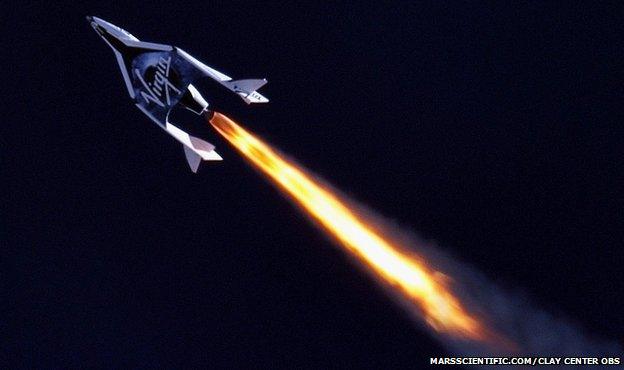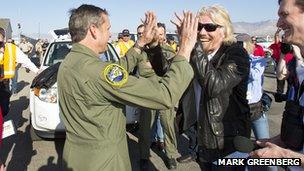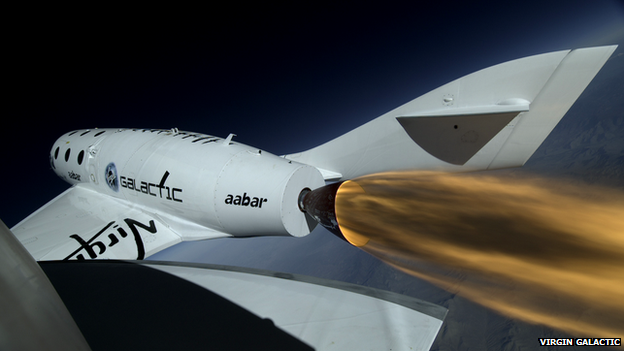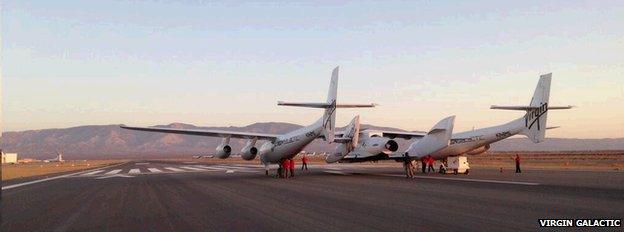Sir Richard Branson's Virgin Galactic spaceship ignites engine in flight
- Published

The spaceplane being developed by UK billionaire Sir Richard Branson has made its first powered flight.
The vehicle was dropped from a carrier aircraft high above California's Mojave Desert and ignited its rocket engine to go supersonic for a few seconds.
Sir Richard's intention is to use the spaceship to carry fare-paying passengers on short pleasure rides above the Earth's atmosphere.
His company Virgin Galactic has already taken hundreds of deposits.
The rocket vehicle is known as SpaceShipTwo (SS2).
Although it has been in the air on more than 20 occasions, this was the first time its hybrid motor had been ignited.
It was only a short burn lasting about 16 seconds, but it propelled SS2 beyond the sound barrier to a speed of Mach 1.2. Future outings should see progressively longer burn durations, enabling the plane eventually to reach sufficient velocity to climb more than 100km into the sky.
Space target
Monday's mission began at the Mojave Air and Space Port at just after 07:00 local time (14:00 GMT). Test pilots Mark Stucky and Mike Alsbury were reported to be at the controls of SS2.
It took off slung beneath the WhiteKnightTwo aircraft, which does the job of lifting the rocket plane to its launch altitude - some 45,000ft (14km).
A little under an hour later, SpaceShipTwo was released, dropped a short distance to get clear of WhiteKnightTwo and then lit its engine, which burns a combination of a solid rubber compound and liquid nitrous oxide.
SpaceShipTwo ignites its engine in flight for the first time
After shutting down its motor, the vehicle then glided back to the Mojave runway, touching down just after 08:00 local time.
Sir Richard said in a statement: "For the first time, we were able to prove the key components of the system, fully integrated and in flight. Today's supersonic success opens the way for a rapid expansion of the spaceship's powered flight envelope, with a very realistic goal of full space flight by the year's end."
Family first
The entrepreneur is reluctant these days to say precisely when SpaceShipTwo will enter commercial service.

Richard Branson greets pilot Mark Stucky after the supersonic flight in SS2
Projections for a start date issued in the early days of the project in the mid-2000s have long since passed as engineers have grappled with the complexities of developing the world's first spaceliner.
The delay appears not to have dissuaded prospective passengers, however.
More than 500 people, including celebrities such as physicist Stephen Hawking and former Dallas actress Victoria Principal, have put down a deposit for a ticket that will cost them about $200,000.
The initial service will be run out of a purpose built facility in the New Mexico desert known as Spaceport America. Each flight will accommodate two pilots and six passengers.
Sir Richard says he will take his family on one of the first outings to demonstrate his faith in the vehicle's safety.

A camera mounted on SS2 itself captures the burn
The rocket plane itself is a derivative of SpaceShipOne, which became the first private manned vehicle to fly to the edge of space and back in 2004.
It was the brainchild of aviation pioneer Burt Rutan, whose Mojave company, Scaled Composites, then designed the current prototype passenger version for Sir Richard.
The pair formed The Spaceship Company to manufacture future vehicles.
There are other companies hoping to offer sub-orbital flights in the near future.
XCOR Aerospace, which also has an operation in Mojave, is developing a smaller rocket plane called Lynx. This would carry one pilot and one ticketed passenger to 100km.
Neither it nor SS2 can achieve the speeds needed to go into orbit.

SpaceShipTwo, slung beneath the carrier aircraft WhiteKnightTwo, prepares for take-off
Jonathan.Amos-INTERNET@bbc.co.uk and follow me on Twitter: @BBCAmos, external
- Published11 December 2012
- Published4 December 2012
- Published11 July 2012
- Published14 December 2011
- Published18 October 2011